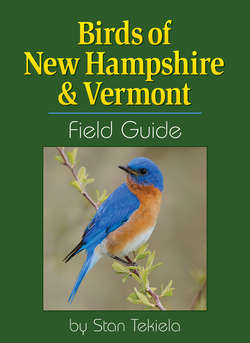Читать книгу Birds of New Hampshire & Vermont Field Guide - Stan Tekiela - Страница 10
На сайте Литреса книга снята с продажи.
OBSERVE WITH A STRATEGY; TIPS FOR IDENTIFYING BIRDS
ОглавлениеIdentifying birds isn’t as difficult as you might think. By simply following a few basic strategies, you can increase your chances of successfully identifying most birds you see! One of the first and easiest things to do when you see a new bird is to note its color. (Also, since this book is organized by color, you will go right to that color section to find it.)
Next, note the size of the bird. A strategy to quickly estimate size is to select a small-, medium- and large-sized bird to use for reference. For example, most people are familiar with robins. A robin, measured from tip of the bill to tip of the tail, is 10 inches (25 cm) long. Using the robin as an example of a medium-sized bird, select two other birds, one smaller and one larger. Many people use a House Sparrow, at about 6 inches (15 cm), and an American Crow, about 18 inches (45 cm). When you see a bird that you don’t know, you can quickly ask yourself, “Is it smaller than a robin, but larger than a sparrow?” When you look in your field guide to help identify your bird, you’ll know it is roughly between 6-10 inches (15-25 cm) long. This will help to narrow your choices.
Next, note the size, shape and color of the bill. Is it long, short, thick, thin, pointed, blunt, curved or straight? Seed-eating birds, such as Northern Cardinals, have bills that are thick and strong enough to crack even the toughest seeds. Birds that sip nectar, such as Ruby-throated Hummingbirds, need long thin bills to reach deep into flowers. Hawks and owls tear their prey with very sharp, curving bills. Sometimes, just noting the bill shape can help you decide whether the bird is a woodpecker, sparrow, grosbeak, blackbird or bird of prey.
Next, take a look around and note the habitat in which you see the bird. Is it wading in a saltwater marsh? Walking along a riverbank or on the beach? Soaring in the sky? Is it perched high in the trees or hopping along the forest floor? Because of their preferences in diet and habitat, you will usually see robins hopping on the ground, but not often eating seeds at a feeder. Or you’ll see a Blue Jay sitting on a tree branch, but not climbing headfirst down a tree trunk like a White-breasted Nuthatch.
Noticing what a bird is eating will give you another clue to help you identify that bird. Feeding is a big part of any bird’s life. Fully one-third of all bird activity revolves around searching for and catching food, or actually eating. While birds don’t always follow all the rules of what we think they eat, you can make some general assumptions. Northern Flickers, for instance, feed upon ants and other insects, so you wouldn’t expect to see them visiting a backyard feeder. Some birds, such as Barn Swallows and Tree Swallows, feed upon flying insects and spend hours swooping and diving to catch a meal.
Sometimes you can identify a bird by the way it perches. Body posture can help you differentiate between an American Crow and a Red-tailed Hawk. American Crows lean forward over their feet on a branch, while hawks perch in a vertical position. Look for this the next time you see a large unidentified bird in a tree.
Birds in flight are often difficult to identify, but noting the size and shape of the wing will help. A bird’s wing size is in direct proportion to its body size, weight and type of flying. The shape of the wing determines if the bird flies fast and with precision, or slowly and less precisely. Birds such as House Finches, which flit around in thick tangles of branches, have short, round wings. Birds that soar on warm updrafts of air, such as Turkey Vultures, have long, broad wings. Barn Swallows have short, pointed wings that slice through the air, propelling their swift and accurate flight.
Some birds have unique patterns of flight that aid in identification. American Goldfinches fly in a distinctive up-and-down pattern that makes it look as if they are riding a roller coaster.
While it’s not easy to make these observations in the short time you often have to watch a “mystery bird,” practicing these methods of identification will greatly expand your skills in birding. Also, seek the guidance of a more experienced birder who will help you improve your skills and answer questions on the spot.
